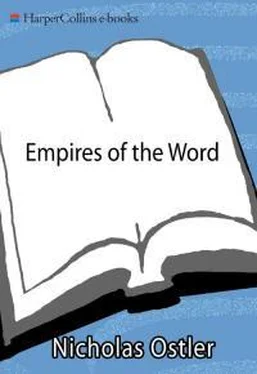This is the precise Sanskrit equivalent of the Greek barbaros , defined as someone who did not speak Sanskrit.
Bizarrely this only happened after Muslim incursions, which had brought in the completely alien Persian as the new elite language.
Indeed, there is a famous story of the embarrassment caused when a king called Satavahana turned out to know less Sanskrit than a lady: in a water fight, one of his queens begged him to stop pelting her with water ( modakaiẖ , from mā udakaiẖ , ‘not with-waters’), but he responded by showering her with sweets ( modakaiẖ , ‘with sweets’). He was so mortified when she pointed out his mistake that he took to his bed, and then embarked on a crash course in grammar (Somadeva, Kathā-sarit-sāgaram , l.vi.108-22).
One gets some idea of how much, and how little, Pali differs from Sanskrit by comparing the Sanskrit equivalent for this phrase: sarvasatāṃ mūlabhāṣā.
He called it Fan , probably a Chinese reduction of the word Brahmana.
The most widely used alphabet in this area of India is still known as deva-nāgarī , ‘the gods’ urban [script]’.
These two terms came to mean ‘slave’ and ‘demon, robber, bandit’ respectively. Compare the development of the English word slave from Slav , and the apparently opposite route taken by Serb from Latin servus. The feminine of dāsa, dāsī , came to mean ‘whore’ ( devadāsī , ‘a god’s slave-girl’, was a temple prostitute), and one of the most routine Sanskrit insults is dāsyaẖ putraẖ , equivalent to ‘whoreson’ or ‘son of a bitch’.
The purpose was to rescue Rama’s kidnapped wife Sita—rather similar to Homer’s motivation for the Trojan War, where a Greek fleet set out to rescue Menelaus’s wife Helen.
In a total reversal, Hinduism was later to renounce even the possibility of foreign voyages. It was held to bring unassuageable impurity upon higher castes, e.g. in the late-thirteenth-century law digest by Hemādri (iii.2: 667).
Devanagari, Gujarati, Panjabi, Bengali, Oriya in the north; Telugu, Kannada, Tamil, Malayalam and Sinhalese in the south. There is another related alphabet, used farther north for Tibetan.
Burmese, Lao, Thai, Khmer (Cambodian) on the mainland; in the islands, Javanese, Balinese, Tagalog (in the Philippines), Batak (in Sumatra) and Bugis (in Sulawesi).
The same word is now pronounced Phnom, as in Phnom Penh.
Java, Sumatra and Malaya are derived from Yava-dvīpa , ‘barley island’; samudra , ‘sea’, and Malaya , actually from a Dravidian word, malai , ‘a hill’, in south India near Malabar. Cambodia ( Kamboja ) evokes Kambuja , a kingdom in the Khyber pass area; but had a competing etymology as Kambu-ja , i.e. born of Kambu Svāyambhūva , a hermit who united with the celestial nymph Mera to found the race of Khmers (Coedès 1968: 66). Champa shares its name with the kingdom of the lower Ganges, but is probably the local ethnonym Cham in Sanskrit form. The River Irrawaddy in Burma is named for the Irāvatī , ‘having drinking water’, the old name of the Ravi river in Panjab.
To an extent, this still continues: so Megawati Sukarnoputri, at the time of writing president of Indonesia, has a name that translates as ‘Cloudy, Beneficent’s Daughter’.
A variant called Siddha-mātṛka , ‘settled alphabet’, or simply Siddha, is the version of the script most generally used in the East Asian (i.e. Mahayana) Buddhist traditions.
The motivation for this is purely historic. It ultimately goes back to an equally arbitrary ‘aleph beth gimel daleth…’ specified by the Phoenicians.
The items in parentheses do not exist separately, in the spelling or the language, for phonetic reasons.
Nevertheless, the script had been modified deftly to represent more effectively features of Tibetan which are alien to the Aryan languages for which Brahmi and all its successors had been designed. Notably, it can distinguish initial vowels that have glottal stops in front of them and those that do not. (In Sanskrit, as in English, a glottal jerk is inserted automatically when a vowel begins an utterance.) The script was later (in the thirteenth century) borrowed by the Chinese at the court of Kublai Khan, to create the ‘Phagspa script for Mongolian, this even being declared the official script of the empire in 1269. It was also used to write Chinese. (See Chapter 4, ‘Holding fast to a system of writing’, p. 156.)
Malacca’s role as an entrepôt firmly established Malay, Bahasa Mělayu , as the lingua franca of the region, and this has lasted up to the present day. (See Chapter 11, ‘Dutch interlopers’, p. 400.) Malacca was itself a colony of šrī Vijaya (Palembang) on Sumatra, also a major trade centre, and that is where the earliest (seventh century) inscriptions in Malay have been found, one of them upriver from the city of Jambi, previously known as Malayu (Hall 1981: 47-8). Ironically enough, ’Bahasa’ is none other than the Sanskrit word bhāṣā , ‘language’.
Although we know that some features, e.g. the tonal accent, and the pronunciation of over-long ( pluti ) vowels, have been lost along the way.
Most famously NRWN KSR (’Nero Emperor’) added up to 666, the number of the Beast in the Book of Revelation.
Ironically, the most lasting contribution of Kanishka’s rule was ‘Shaka’ era, a dating system still in use in India. It runs from AD 78, and is even used in many of the Sanskrit inscriptions of South-East Asia.
The three fabled libraries of Nalanda, Ratnodadhi (’sea of jewels’), Ratnasāgara (’ocean of jewels’) and Ratnaraṇjaka (’jewel-adorned’), were all to be burnt down. Perhaps it is significant that, according to Tibetan Buddhist accounts of their end, the fires resulted from spells cast by visitors affronted by the rudeness they received from the scholars of Nalanda.
The name Urdu is short for zabān eurdū e muallā , Persian for ‘language of the camp exalted’, where the first and last words are originally Arabic, the middle one Turkic, and the linking e’s pure Persian. Hindi is a shortening of Hindui or Hindvi, the word for ‘Indian talk’ originally used by Muslims, since the word Hind itself is a Persian version of the name of the Sindhu river, known to the Greeks (and Europeans) as the Indus.
For the view from the English side, see Chapter 12, ‘Changing perspective—English in India’, p. 501.
It was the name for some of Achilles’ people in Homer’s Iliad (ii.684), and since he was the greatest Greek hero in that greatest of Greek poems, this may have been sufficient to name the whole race by association.
Читать дальше











